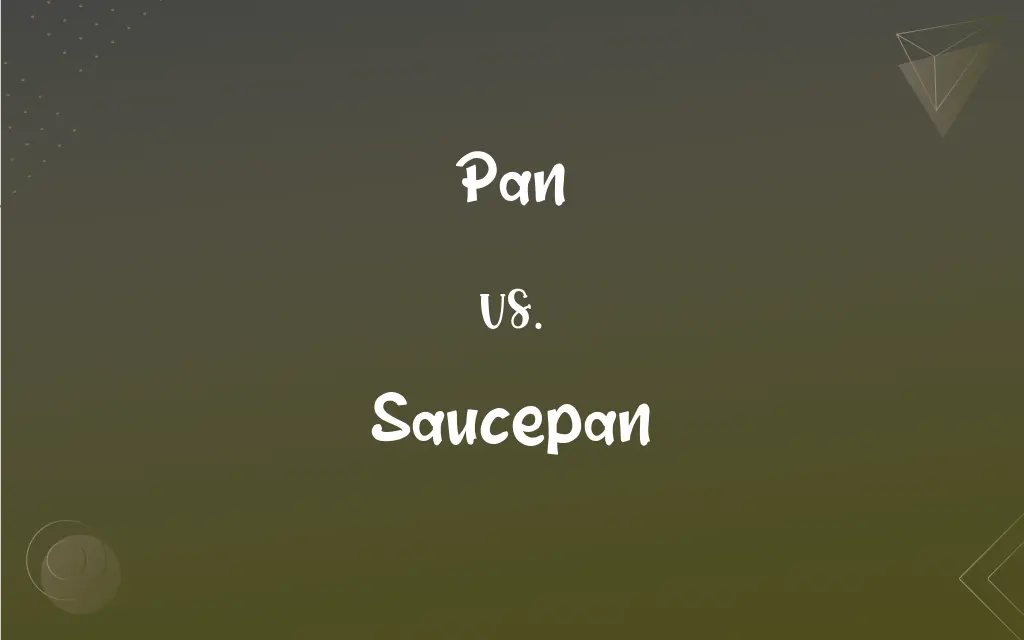Pan vs. Saucepan: What's the Difference?
Edited by Aimie Carlson || By Janet White || Updated on September 29, 2023
A pan is a broad, flat-bottomed cooking vessel often used for frying or sautéing. A saucepan is a specific type of pan with high sides and a long handle, typically used for simmering or boiling liquids.

Key Differences
A pan serves as a versatile kitchen tool with a flat bottom, designed for tasks like frying, sautéing, and more. A saucepan, however, has higher sides and is often equipped with a lid, which makes it ideal for simmering and boiling.
When you think of a pan, it's likely the image of a flat skillet comes to mind. Conversely, a saucepan often brings to mind a vessel that looks more like a pot than a pan, with a distinct function of containing liquids.
In terms of shape, a pan is generally more shallow, allowing for the easy flipping or turning of food items. A saucepan, with its deeper structure, is designed for activities that involve liquids, such as making sauces or cooking pasta.
While many people use the word pan to colloquially refer to any sort of cooking vessel, a saucepan is a more specialized term that denotes a specific function and form.
A pan may or may not come with a lid, as its primary function doesn't necessarily require one. However, a saucepan often includes a lid to aid in simmering, boiling, or reducing liquids more effectively.
ADVERTISEMENT
Comparison Chart
Definition
Broad cooking vessel
High-sided pan
Typical Use
Frying, sautéing
Simmering, boiling
Shape
Generally shallow
Generally deep
Lid
Optional
Usually included
Specificity of Term
More generic
More specific
ADVERTISEMENT
Pan and Saucepan Definitions
Pan
Pan: A flat-bottomed cooking vessel.
I fried the eggs in a pan.
Saucepan
Usually comes with a lid.
I covered the saucepan with its matching lid.
Pan
Pan: May or may not have a lid.
The pan didn't have a lid, so I used aluminum foil.
Saucepan
A deep cooking vessel with high sides.
I boiled the pasta in a saucepan.
Pan
Pan: Versatile kitchen tool.
From pancakes to stir-fries, the pan is incredibly versatile.
Saucepan
Primarily used for simmering or boiling.
I simmered the tomato sauce in a saucepan.
Pan
A shallow, wide, open container, usually of metal and without a lid, used for holding liquids, cooking, and other domestic purposes.
Saucepan
Ideal for liquid-based cooking.
Making soup is easier in a saucepan.
Pan
An open metal dish used to separate gold, other precious metals, or gemstones from gravel or waste by washing.
Saucepan
Often has a long handle for easy gripping.
The saucepan's long handle made it easy to move.
Pan
Either of the receptacles on a balance or pair of scales.
Saucepan
A deep cooking pan with a handle.
Pan
A vessel used for boiling and evaporating liquids.
Saucepan
A deep cooking vessel with a handle and sometimes a lid; used for boiling, stewing and making sauces.
Pan
A basin or depression in the earth, often containing mud or water.
Saucepan
To cook in a saucepan
Pan
A natural or artificial basin used to obtain salt by evaporating brine.
Saucepan
A small pan with a handle, in which sauce is prepared over a fire; a stewpan.
Pan
Hardpan.
Saucepan
A deep pan with a handle; used for stewing or boiling
Pan
A freely floating piece of ice that has broken off a larger floe.
Pan
The small cavity in the lock of a flintlock used to hold powder.
Pan
(Music) A steel drum.
Pan
(Slang) The face.
Pan
(Informal) Severe criticism, especially a negative review
Gave the film a pan.
Pan
Variant of paan.
Pan
A pivoting movement of a movie camera.
Pan
Peroxyacetyl nitrate
Pan
Greek Mythology The god of woods, fields, and flocks, having a human torso and head with a goat's legs, horns, and ears.
Pan
To wash (gravel, for example) in a pan to separate out gold, other precious metals, or gemstones.
Pan
To cook (food) in a pan
Panned the fish right after catching it.
Pan
(Informal) To criticize or review harshly.
Pan
To wash gravel, sand, or other sediment in a pan.
Pan
To yield gold as a result of washing in a pan.
Pan
To pivot a movie camera along a horizontal plane in order to follow an object or create a panoramic effect.
Pan
To pivot (a movie camera) in a specified direction.
Pan
A wide, flat receptacle used around the house, especially for cooking.
Pan
The contents of such a receptacle.
Pan
A cylindrical receptacle about as tall as it is wide, with one long handle, usually made of metal, used for cooking in the home.
Pan
(Ireland) A deep plastic receptacle, used for washing or food preparation; a basin.
Pan
A wide receptacle in which gold grains are separated from gravel by washing the contents with water.
Pan
An expanse of level land located in a depression, especially
Pan
A pond or lake, considered as the expanse of land upon which the water sits.
Pan
A dry lake or playa, especially a salt flat.
Pan
(South Africa) playa lake: a temporary pond or lake in a playa.
Pan
: a flat artificial pond used for collecting minerals from evaporated water.
Pan
(geology) nodot=a: a hard substrate such as is formed in pans.
Pan
Syn of pipe: a channel for lava within a volcano; the cylindrical remains of such channels.
Pan
Strong adverse criticism.
Pan
A loaf of bread.
Pan
The chamber pot in a close stool; the base of a toilet, consisting of the bowl and its support.
Pan
(slang) A human face, a mug.
Pan
(roofing) The bottom flat part of a roofing panel that is between the ribs of the panel.
Pan
A closed vessel for boiling or evaporating as part of manufacture; a vacuum pan.
Pan
(firearms) The part of a flintlock that holds the priming.
Flash in the pan
Pan
The skull, considered as a vessel containing the brain; the brainpan.
Pan
(figurative) The brain, seen as one's intellect.
Pan
(carpentry) A recess, or bed, for the leaf of a hinge.
Pan
(musical instrument) steelpan
Pan
A part; a portion.
Pan
(fortifications) The distance comprised between the angle of the epaule and the flanked angle.
Pan
A leaf of gold or silver.
Pan
(transitive) To wash in a pan (of earth, sand etc. when searching for gold).
Pan
(transitive) To disparage; to belittle; to put down; to harshly criticize, especially a work (book, movie, etc.)
Pan
To turn out well; to be successful.
Pan
To beat one's opposition convincingly.
Pan
To turn horizontally.
Pan
To move the camera lens angle while continuing to expose the film, enabling a contiguous view and enrichment of context. In still-photography large-group portraits the film usually remains on a horizontal fixed plane as the lens and/or the film holder moves to expose the film laterally. The resulting image may extend a short distance laterally or as great as 360 degrees from the point where the film first began to be exposed.
Pan
To shift an image relative to the display window without changing the viewing scale.
Pan
(audio) To spread a sound signal into a new stereo or multichannel sound field, typically giving the impression that it is moving across the sound stage.
Pan
To join or fit together; to unite.
Pan
(informal) Pansexual or panromantic.
Pan
A part; a portion.
Pan
The distance comprised between the angle of the epaule and the flanked angle.
Pan
A leaf of gold or silver.
Pan
The betel leaf; also, the masticatory made of the betel leaf, etc. See Betel.
Pan
A shallow, open dish or vessel, usually of metal, employed for many domestic uses, as for setting milk for cream, for frying or baking food, etc.; also employed for various uses in manufacturing.
Pan
A closed vessel for boiling or evaporating. See Vacuum pan, under Vacuum.
Pan
The part of a flintlock which holds the priming.
Pan
The skull, considered as a vessel containing the brain; the upper part of the head; the brainpan; the cranium.
Pan
A recess, or bed, for the leaf of a hinge.
Pan
The hard stratum of earth that lies below the soil. See Hard pan, under Hard.
Pan
A natural basin, containing salt or fresh water, or mud.
Pan
To join or fit together; to unite.
Pan
To separate, as gold, from dirt or sand, by washing in a kind of pan.
We . . . witnessed the process of cleaning up and panning out, which is the last process of separating the pure gold from the fine dirt and black sand.
Pan
To criticise (a drama or literary work) harshly.
Pan
To yield gold in, or as in, the process of panning; - usually with out; as, the gravel panned out richly.
Pan
To turn out (profitably or unprofitably); to result; to develop; as, the investigation, or the speculation, panned out poorly.
Pan
To scan (a movie camera), usu. in a horizontal direction, to obtain a panoramic effect; also, to move the camera so as to keep the subject in view.
Pan
The god of shepherds, guardian of bees, and patron of fishing and hunting. He is usually represented as having the head and trunk of a man, with the legs, horns, and tail of a goat, and as playing on the shepherd's pipe (also called the pipes of Pan), which he is said to have invented.
Pan
Cooking utensil consisting of a wide metal vessel
Pan
(Greek mythology) god of fields and woods and shepherds and flocks; represented as a man with goat's legs and horns and ears; identified with Roman Sylvanus or Faunus
Pan
Shallow container made of metal
Pan
Chimpanzees; more closely related to Australopithecus than to other pongids
Pan
Make a sweeping movement;
The camera panned across the room
Pan
Wash dirt in a pan to separate out the precious minerals
Pan
Express a totally negative opinion of;
The critics panned the performance
Pan
Pan: Used for frying or sautéing.
The vegetables were sautéed in the pan.
Pan
Pan: Made from various materials like cast iron or non-stick.
I prefer using a cast-iron pan for better heat retention.
FAQs
Can a pan be used for boiling?
While you can technically boil in a pan, a saucepan is generally more suitable for this task.
What is a pan?
A pan is a broad, flat-bottomed cooking vessel often used for frying or sautéing.
What is a pan primarily used for?
A pan is primarily used for frying, sautéing, and other high-heat, quick-cooking methods.
What materials are saucepans made of?
Saucepan materials range from stainless steel to non-stick and even copper.
What are the common uses of a saucepan?
A saucepan is commonly used for simmering, boiling, and making sauces.
Does every saucepan have a lid?
Most saucepans come with a lid, but it's not a strict requirement.
Is a saucepan a type of pan?
Yes, a saucepan is a specific type of pan designed for certain cooking tasks.
Can a pan have high sides?
While some pans have moderately high sides, they are usually not as deep as saucepans.
Do I need both a pan and a saucepan?
Having both is beneficial for versatility, as each is optimized for different cooking tasks.
What materials are pans made of?
Pans can be made of various materials like cast iron, stainless steel, and non-stick coatings.
What is a saucepan?
A saucepan is a deep, high-sided pan typically used for simmering or boiling liquids.
Can I fry in a saucepan?
It is possible but not ideal; a regular pan is better suited for frying.
Are pans and saucepans interchangeable?
They can be used for some overlapping tasks, but each has its specialized functions.
Is a saucepan deeper than a pan?
Yes, a saucepan generally has higher sides, making it deeper than most pans.
Can a saucepan be flat-bottomed?
Most saucepans have a flat bottom but are distinguished by their high sides.
About Author
Written by
Janet WhiteJanet White has been an esteemed writer and blogger for Difference Wiki. Holding a Master's degree in Science and Medical Journalism from the prestigious Boston University, she has consistently demonstrated her expertise and passion for her field. When she's not immersed in her work, Janet relishes her time exercising, delving into a good book, and cherishing moments with friends and family.
Edited by
Aimie CarlsonAimie Carlson, holding a master's degree in English literature, is a fervent English language enthusiast. She lends her writing talents to Difference Wiki, a prominent website that specializes in comparisons, offering readers insightful analyses that both captivate and inform.































































